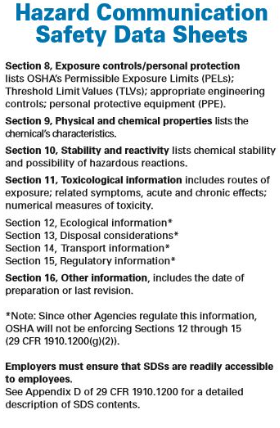When you hear of yet another hazmat incident due to improper storage what is the first thing to come to mind? If you’re not in proximity of the incident, you might wonder why does this keep happening? “Are these workers really so careless on the job to leave volatile chemicals lying around exposed?” More often than not, fires, explosions and leaks comes down to one common theme: improper storage. Instead of consulting the experts at U.S. Hazmat Storage for their chemical safety needs, they’ve thrown caution to the wind and decided to wing it when it comes to storing stockpiles of hazardous materials. We see this time and time again. Negligence on the jobsite leads to frantic safety engineers picking up the phone and calling us to cure their chemical storage woes. By the time they peck away at their keypads, the damage has been done. Fines continue to rack up as they question their financial solvency. Understanding safety data sheets saves lives and gives stern guidance on where and under what conditions to store flammable chemicals.
What are Safety Data Sheets?

Safety Data Sheets are the cheat sheets for any hazardous material that falls under governmental purview. They contain pertinent information to each type of dangerous chemical on the market, including physical, health and environmental health hazards. As well as the hazardous classification – such as flammable or corrosive – a SDS also provides the boiling, melting and flash points of dangerous chemicals. These condense chemical play cards have it all. Chemical engineers have even gone as far as to list recommended fire suppression for each chemical, as well as how to handle, transport and store every compound imaginable. Safety Data Sheets should be readily accessible on every jobsite. While the sheets’ language might come across as pretty dry and boring, they cannot underscore the importance enough of becoming well-versed in the bespoken language of each chemical.
How To Properly Understand Safety Data Sheets
We won’t ask you to dust off your high school chemistry book just yet, but understanding the technical jargon of dangerous chemicals comes with the territory of industrial manufacturing. But there could be dozens, if not hundreds of different chemicals of varying classifications on any jobsite. How can you keep track of them all? While careful and consistent studying goes a long way in protecting the workforce, you have deadlines to meet and clients to cultivate. There’s simply not enough time to become an expert. At U.S. Hazmat Storage, our experienced building advisors are your go-to-tutors for all things chemical. Just tell us what hazardous material you need storage for. We will quickly present a bevy of fire-rated or non-fire-rated (depending on the use) chemical storage options. With an in-depth consultation, we can assess what type of chemical storage and pertinent safety apparatuses you will need to stay compliant and off the OSHA radar.
Avoid Fines and Protect the Bottomline

Nothing eats away at profits like unforeseen expenses, such as fines. Staying abreast of rapidly changing chemical storage laws is a daunting task. And despite your best pleading, ignorance is never an accessible excuse for abiding all laws of chemical storage. While OSHA doesn’t require safety data sheets for non-hazardous materials, the chances remain high that you have at least a few dangerous chemicals that require vigilance. Regardless of the quantity, you need a safety data sheet for each hazardous material. Stay informed and protected by consulting with U.S. Hazmat Storage for all your chemical needs. Don’t worry about the size and quantity. We will take care of the job from start to finish. We have a full arsenal of formidable chemical storage lockers for every workforce and application. Don’t become a statistic. Call us today for a free quote.


